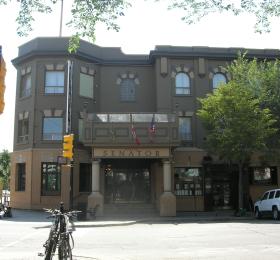Senator Hotel
- Holding Bylaw
Description of the Historic Place
The Senator Hotel (originally called the Flanagan Hotel) is a three-story brick building in the city's Central Business District. Built in 1907, the Senator Hotel is considered to be a landmark building in Saskatoon.
This historic place, located at 243 21st St East, is listed under Bylaw No. 6770 (Holding Bylaw). This Bylaw provides short-term protection of the building from demolition by providing for a 60 day holding period in the event a demolition permit is received. Within that 60 day period heritage designation is considered by City Council.
Heritage Value
James Flanagan came to Saskatoon from Ontario in 1902, and although he was best known as an hotelier, Flanagan, like many of his contemporaries, speculated in local real estate. Shortly after his arrival, Flanagan began building the Western Hotel (located on 2nd Avenue) which opened in 1903. By 1907 - 1908 the focus of the downtown was edging northwards to 21st Street. Recognizing this trend, Flanagan sold the Western Hotel and began the construction of the Flanagan Hotel, with the assistance of the Shannon Brothers. This was the first building constructed in Canada by the Shannon Brothers, and they would go on to become prominent builders in Saskatoon after completing this hotel.
Designed by Walter W. LaChance, the Hotel’s opening in 1908 was attended by hundreds of people who saw the Flanagan as a symbol of Saskatoon's modernity and future prosperity. The hotel was considered to be upscale at the time, and catered mostly to commercial men or travelers, with several prominent businessmen making it their headquarters. The original three-storey L-shaped building was made of solid brick and had two wings; one on 21st Street and one on 3rd Avenue. On the northeast corner there was a turret surmounted by a cupola. The building had a flat parapet roofline with galvanized metal coping. Inside, the Flanagan was outfitted with what was considered modern conveniences at the time, including electricity, steam heating, hot and cold running water, and telephones. The hotel was also elaborately furnished and decorated. There was lavish use of marble, ornamental scrolls, crystal chandeliers, ornate mouldings and friezes and intricate wrought-iron work.
The onset of the Depression caused some major changes to the hotel. The dining room on the 3rd Avenue side was closed and the area was converted to suites. The large lobby was rebuilt to accommodate retail stores, and the corner office was taken over by Dr. Fred Salisbury who remained at this location for 30 years. The 1950s left marks of modernization on the hotel - drop ceilings were installed, main floor windows were filled in with glass blocks, the lobby was altered and even the façade was changed. In 1964 the exterior of the hotel was aggressively modernized; the top frieze was removed, the angle niche in the corner of the building from which the tower had projected was filled in, the lower part of the building was covered in ceramic tile, and the bricks on the second and third floors were painted.
Attempts to restore the original exterior characteristics of the hotel have been made in recent years. The building cornice and the canopy over the main entrance were restored in 1990 and the façade had a major restoration which included the removal of the brick which had hidden the outlines of the original corner turret, in 1995. In commemoration of this work, the Senator Hotel received an award for the sympathetic restoration of a commercial building in 1998 through the City’s Heritage Awards Program, and in 2004 the hotel was awarded for its interior restoration.
Source: City of Saskatoon Built Heritage Database
Character Defining Elements
Key elements which contribute to the heritage value of this historic place include:
- Its vernacular and eclectic architecture, evident in: the outline of the original corner turret, main floor brick façade, building cornice, columns and canopy over the main entrance; its third floor arched windows; and its flat parapet roofline; and
- Those features that represent the building’s historical and cultural significance such as its prominent location in Saskatoon’s downtown and its form, scale and massing.


